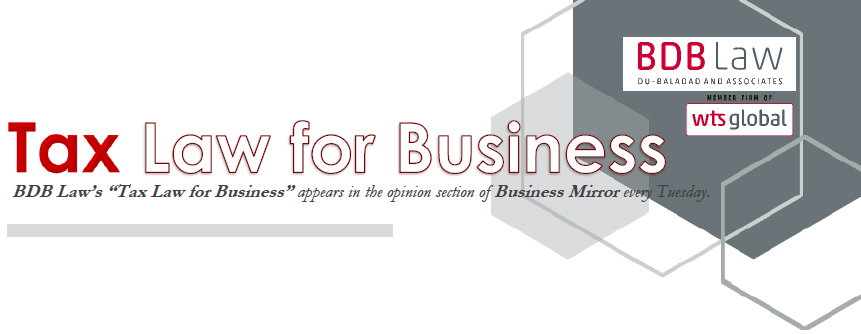Atty. Irwin Nidea Jr. discusses the nuances and safeguards for taxpayers when dealing with the nightmare of being served to LOAs in a year ...

When LOA Strikes Twice
By Atty. Irwin C. Nidea Jr.
"The Tax Code provides that any assessment of internal revenue taxes against any taxpayer shall only be done within the three-year period after the last day prescribed by law for the filing of their respective returns unless if the payment of said internal revenue taxes was attended with fraud. If there is no indication in the LOA that the tax examination that would be conducted by the BIR is the result of any findings of fraud against the taxpayer, the three-year period should be applied."
How rare is it to get struck by lightning twice? Google says it’s around one in nine million. Does it have the same probability as a taxpayer being served with a Letter of Authority (LOA) not once but twice for the same taxable year? I would say that the odds are probably in favor of taxpayers being served two LOAs. But is the service of more than one LOA for the same taxable year justified under the law? Are there remedies available to taxpayers who will be awaken by the same nightmare twice?
 In many decisions, the courts clarified that for income tax purposes examination and inspection of a taxpayer’s books of accounts shall be made only once in a taxable year. In other words, generally, a taxpayer can only be issued one LOA for one taxable year. The revenue officers can only conduct their examination once. Like everything in life, misery must end. Taxpayers must be given the peace of mind that they deserve, after a tax assessment has been concluded.
In many decisions, the courts clarified that for income tax purposes examination and inspection of a taxpayer’s books of accounts shall be made only once in a taxable year. In other words, generally, a taxpayer can only be issued one LOA for one taxable year. The revenue officers can only conduct their examination once. Like everything in life, misery must end. Taxpayers must be given the peace of mind that they deserve, after a tax assessment has been concluded.
Unfortunately, the same as any rule, there are exceptions. A taxpayer may be issued a second LOA for the same taxable year if there is fraud, irregularity, or mistakes, as determined by the Commissioner. So, if a taxpayer has committed fraud in the preparation and payment of his tax returns, a second LOA is forthcoming. Does this mean that even after an assessment has been concluded, the BIR can bring an assessment back from the grave and there is no time limit for them to exercise this power?
As regards the first question, according to the courts, the discovery of substantial under declaration upon verified information provided by an "informer", as well as the necessity of obtaining information from third parties to ascertain the correctness of the return filed or evaluation of tax compliance in collecting taxes, are circumstances warranting exception from the general rule. If the substantial underdeclared income in the returns filed by the taxpayers are amounts equivalent to more than thirty percent constitutes prima facie evidence of fraud. In this case, the law allows the issuance of a second LOA for the same taxable year.
The next question is whether the BIR can conduct a second examination indefinitely? This is a valid concern since the BIR might decide to investigate transactions that happened ten years ago. Supporting documents that can counter a BIR assessment might no longer be available at the time of examination.
The Tax Code provides that any assessment of internal revenue taxes against any taxpayer shall only be done within the three-year period after the last day prescribed by law for the filing of their respective returns unless if the payment of said internal revenue taxes was attended with fraud. If there is no indication in the LOA that the tax examination that would be conducted by the BIR is the result of any findings of fraud against the taxpayer, the three-year period should be applied.
The courts said that a second LOA is void if prescription to assess has set in. While the period to assess may be made within the extraordinary period of 10 years pursuant to the Tax Code, it must be shown that the tax examination that would be conducted by the BIR was the result of any findings of fraud against the taxpayer. In other words, it must be shown that the second LOA was issued for the conduct of a formal fraud investigation. For example, substantial under declaration upon verified information provided by an "informer" was discovered by the BIR. The BIR must conduct a preliminary investigation first and show that there is a finding of prima facie existence of fraud that justifies the issuance of the second LOA before the same may be issued.
In ordinary cases where fraud assessment is not involved, a second LOA may still be issued if the prior assessment for the same taxable year is not closed and terminated. There are instances when taxpayers pay based on a memorandum or worse based on a mere informal computation prepared by the BIR. Payment without issuance of Termination Letter or Authority to Cancel Assessment (ATCA) or BIR Form No. 17.58 will give the BIR an opening. It may reopen the case, issue a new LOA, and argue that the new investigation is just a continuation of the old LOA.
In sum, taxpayers must be aware that the BIR cannot issue a second LOA for the same taxable year out of whim. It must be shown that a preliminary investigation was conducted and there is a finding of prima facie existence of fraud as a result thereof. Also, taxpayers must not only rely on an informal computation sheet when paying a tax assessment and they must always secure a termination letter or ATCA to protect themselves from being stricken by lightning twice.
The author is a senior partner of Du-Baladad and Associates Law Offices (BDB Law), a member-firm of WTS Global.
The article is for general information only and is not intended, nor should be construed as a substitute for tax, legal or financial advice son any specific matter. Applicability of this article to any actual or particular tax or legal issue should be supported therefore by a professional study or advice. If you have any comments or questions concerning the article, you may e-mail the author at This email address is being protected from spambots. You need JavaScript enabled to view it. or call 8403-2001 local 330.



